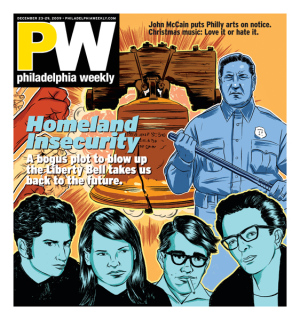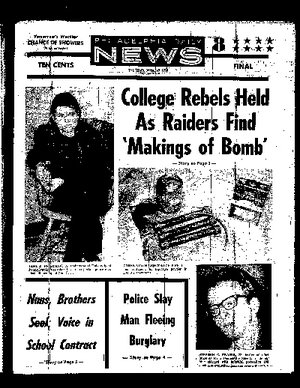#PhillyIsBaltimore protesters curse the statue — and the brutally racist legacy — of Frank Rizzo last night. [via PHILLY MAG]
PHILADELPHIA WEEKLY: In the spring of 1969, four activists from the Philadelphia chapter of the Students for a Democratic Society (SDS) were arrested for plotting to blow up the Liberty Bell after the police found bomb-making materials in the refrigerator of a West Philly apartment. According to the police, the planned destruction of the Liberty Bell was part of a larger plot hatched by a network of student radicals to destroy national landmarks across the country. ?
The shocking news spread quickly when footage of the police search of the apartment surfaced—captured by a KYW film  crew invited in by police to document the raid—and the ensuing arrests made the evening news. The Daily News trumpeted details of the plot in two separate cover stories with the blaring headlines “College Rebels Held as Raiders Find ‘Makings of Bomb’” and “Rebel Student Plot to Blow Up Phila. Historical Shrines Revealed by Police.” ?
crew invited in by police to document the raid—and the ensuing arrests made the evening news. The Daily News trumpeted details of the plot in two separate cover stories with the blaring headlines “College Rebels Held as Raiders Find ‘Makings of Bomb’” and “Rebel Student Plot to Blow Up Phila. Historical Shrines Revealed by Police.” ?
A potentially tragic incident of domestic terrorism was narrowly averted, it seemed, thanks to the aggressive due diligence of the Philadelphia Police Department and its take-no-bull commissioner Frank Rizzo. There was just one problem: There was no plot to blow up the Liberty Bell and no evidence that the four activists had acquired any bomb-making materials. None of that really mattered, though. ?MORE
RELATED: To fully understand the significance of the ?case, it must be placed in the wider context of ?the Philadelphia Police Department’s war on per-?ceived subversives in the late ’60s—the way they systematically harassed, intimidated and brutalized blacks and white college-boy troublemakers—under Frank Rizzo’s leadership. Rizzo had been known to routinely invent or exaggerate these threats to scare the public and amass political power, resulting in two contentious and deeply divisive terms as mayor in the 1970s. ?MORE
 RELATED: The leader of [Rizzo’s] Civil Disobedience Unit was Lt. George Fencl, a thick-necked man with slicked-back salt-and-pepper hair. Fencl was a regular fixture at protests and demonstrations in the ’60s and ’70s. It was his job to monitor, identify, photograph and track dissident groups and their sympathizers. Fencl, dressed in his trademark black overcoat with a white armband emblazoned with the word POLICE, and his CDU boys would show up at demonstrations and photograph everyone in the crowd, taking down names and license-plate numbers of those participating. Sometimes Fencl’s men would brandish cameras that had no film, snapping away nonexistent pictures to intimidate and disperse protesters. ?On a 1970 episode of NBC news program First Tuesday, Fencl bragged that the police had a list of over 18,000 names [of dissidents]. He also enlisted an army of informers, some of which were criminals cooperating in exchange for charges being dropped and others the wives of police officers encouraged to join activist groups and report back to the CDU in exchange for “pin money.” MORE
RELATED: The leader of [Rizzo’s] Civil Disobedience Unit was Lt. George Fencl, a thick-necked man with slicked-back salt-and-pepper hair. Fencl was a regular fixture at protests and demonstrations in the ’60s and ’70s. It was his job to monitor, identify, photograph and track dissident groups and their sympathizers. Fencl, dressed in his trademark black overcoat with a white armband emblazoned with the word POLICE, and his CDU boys would show up at demonstrations and photograph everyone in the crowd, taking down names and license-plate numbers of those participating. Sometimes Fencl’s men would brandish cameras that had no film, snapping away nonexistent pictures to intimidate and disperse protesters. ?On a 1970 episode of NBC news program First Tuesday, Fencl bragged that the police had a list of over 18,000 names [of dissidents]. He also enlisted an army of informers, some of which were criminals cooperating in exchange for charges being dropped and others the wives of police officers encouraged to join activist groups and report back to the CDU in exchange for “pin money.” MORE
